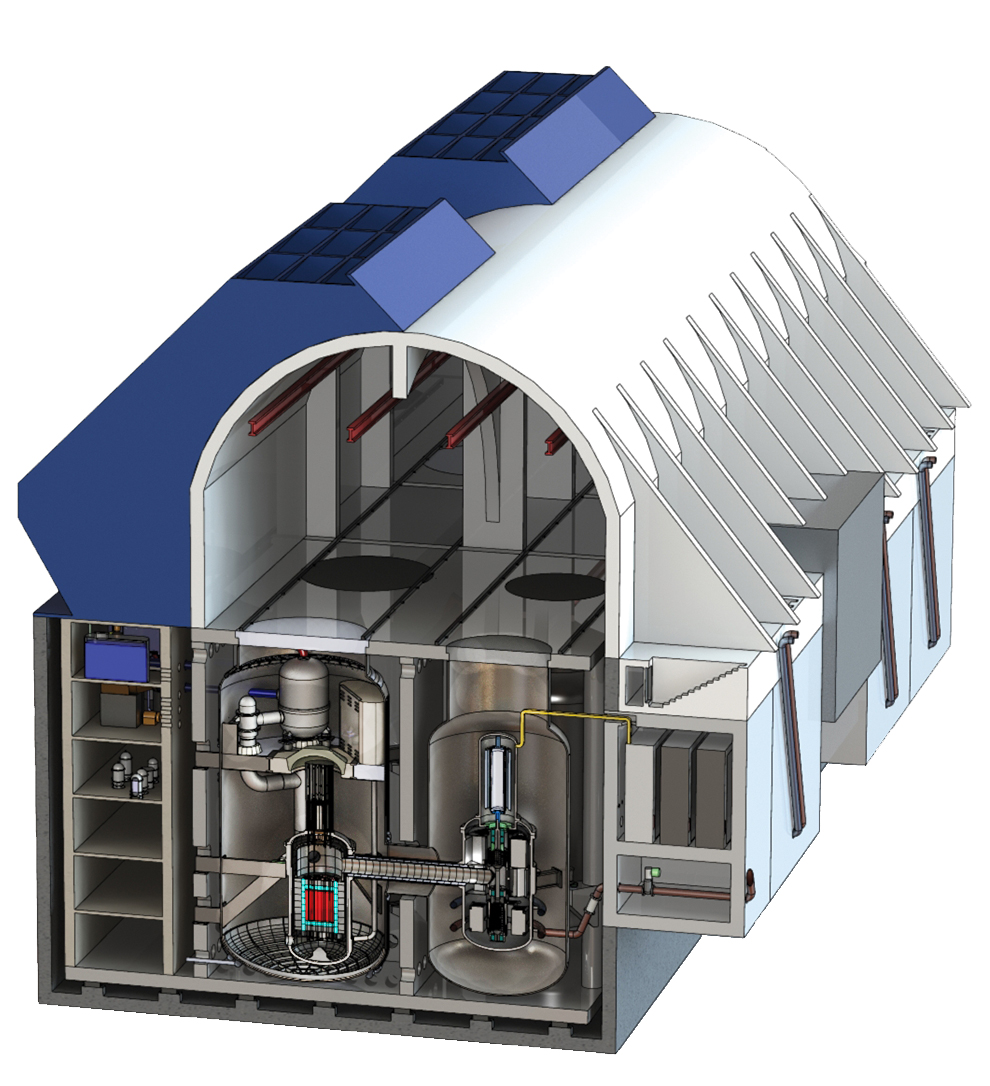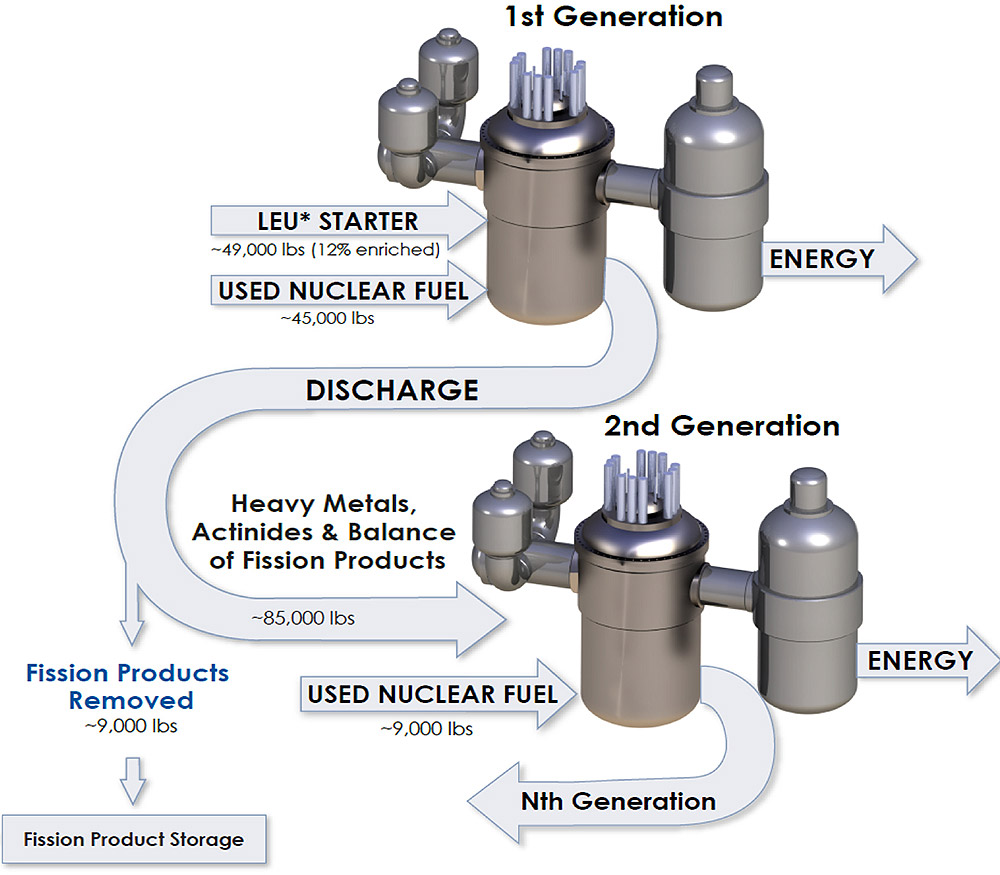Advanced Reactors
General Atomics Electromagnetic Systems (GA-EMS) has been at the forefront of innovation in nuclear energy since its founding in 1955. GA-EMS seeks to develop and deploy reactors that advance the state of the art in efficiency, safety, and economics. In this pursuit, GA-EMS draws upon particular expertise and experience with high-temperature, gas-cooled reactors, starting with the Peach Bottom and Fort St. Vrain projects in partnership with the Department of Energy.
Today, as the nuclear industry faces unprecedented challenges to its future, GA-EMS is helping develop the next generation of advanced reactors. GA-EMS' Energy Multiplier Module (EM2) is an advanced small modular reactor (SMR) that addresses four of the most challenging problems facing nuclear energy: economics, safety, waste, and nonproliferation.
EM2 is a helium-cooled fast reactor with a core outlet temperature of 850°C. It is designed as a modular, grid-capable power source with a net unit output of 265 MWe. The reactor employs a "convert and burn" core design which converts fertile isotopes to fissile and burns them in situ over a 30-year core life. The reactor is sited in a below-grade sealed containment and uses passive safety methods for heat removal and reactivity control to protect the integrity of the fuel, reactor vessel and containment. EM2 also employs a direct closed-cycle gas turbine power conversion unit for added efficiency.
Economics

EM2 evolved from a parallel design and cost modelling effort to enable rapid feedback between design decisions and their impact on power cost, thus identifying key cost drivers and targeting them for reduction. Because the cost of capital is one of the largest challenges for nuclear plant construction due to long, uncertain construction periods, EM2 is designed for factory fabrication and modular construction. All components are road transportable. These approaches allow a four-unit EM2-based plant to be completed in just 42 months.
Its higher operating temperature and direct-drive power conversion unit allow EM2 to achieve a 53% net thermal efficiency, compared to 30% to 35% for current light-water reactors. The simpler direct-drive system also means reduced construction costs, since elements such as the steam generators, the main steam system and the feedwater-condensate system are eliminated.
The "convert and burn" approach means EM2 utilizes its uranium fuel much more efficiently, generating more power from the same core volume. EM2 can also use a variety of fuels, including spent fuel from light water reactors.

Safety
EM2 uses an array of passive safety measures to achieve substantially safer operation than current designs. The fuel, fuel rod cladding, and reactor core and core structures are manufactured from GA-EMS' proprietary SiGA® silicon-carbide composite, a high-tech ceramic matrix composite that can withstand more than twice the temperatures of the metal components used in current reactors. SiGA® makes the core virtually meltdown-proof and Fukushima-type accidents almost impossible. Next, a pair of redundant Direct Reactor Auxiliary Cooling Systems (DRACS) are capable of 100% core heat removal via natural circulation, without any actuation or operator intervention, even under "station blackout" conditions. Finally, the reactor containment structure is situated entirely below grade, providing added protection from external events.
Waste
The efficient use of fuel by EM2 means that it generates a fraction of the high-level waste produced by current reactors. In addition, rather than sending spent fuel out for geologic storage, EM2 is capable of recycling its used fuel once some of the fission products are removed. No liquid reprocessing is necessary, and no heavy metals are separated. Even better, these fission products require only about 500 years of storage before decaying to background levels, compared to 10,000 years or longer required for current designs.

In addition, EM2 has the potential to reduce our waste stockpile because it can be powered with this spent fuel. Deployed in sufficient numbers, EM2 is capable of substantially reducing pressures for long-term storage and turning our waste stockpile into an important energy resource.
Nonproliferation
Because EM2 uses more of its uranium fuel and converts it more efficiently to energy, it can operate up to 30 years on the same load of fuel. This compares very favorably to the approximately 18-month fuel cycle of a typical light water reactor. This means that fuel handing is greatly reduced. Because refueling occurs so infrequently, equipment needed to access the core would not be stored on site, and opportunities to access the core are virtually eliminated. Even if EM2 fuel is recycled as discussed above, the recycling process only removes fission products and does not separate out any fissile materials.
GA-EMS' ongoing work on EM2 has been the subject of a number of scientific papers and presentations. A current list of these can be found here.